The arm of a woman who works at the Garold Wayne Interactive Zoological Park in Oklahoma was nearly torn from the woman’s body last week following a mauling during a seemingly routine Saturday morning.
The woman, Kelci Saffery, 27, survived the ordeal and vows to return to work after her full recovery. She also blames none other than herself for the mishap that nearly took her arm:
“On Oct. 5, I broke protocol and stuck my hand in a cat cage instead of using the stick provided,” she wrote in a public statement. “The cat let go and pushed my arm back through the cage … this tiger was not aggressive toward me.”
The problem with backyard zoos
Whether you’re an employee of a backyard zoo or an internationally known zoo housed in San Diego, you should know better than to stick your hand inside a tiger cage. Thus, for Saffery to admit her wrongdoing is good, but her accident still reminds us of this phenomenon known as “backyard zoos” and ignites the debate on whether these zoos ought to exist.
Backyard zoos run the gamut from tiny little gatherings of animals to massive compounds with hundreds of animals. Many backyard zoos aren’t accredited by the Association of Zoos and Aquariums and are privately owned. Organizations such as PETA and the Humane Society have admonished the idea of backyard zoos for years, while other organizations, such as NatGeo, have had reality shows revealing what life is like for backyard zookeepers.
Opponents of backyard zoos, sometimes called “roadside zoos” say that these zoos are designed for the sole purpose of amusing and entertaining customers, with animal welfare being second on the list. But zookeepers are not welcoming that idea with open arms.
Take, for example, the Garold Wayne Interactive Zoological Park (where this recent tiger mauling occurred). PETA and the Humane Society have complained about Joe Schreibvogel, who formerly owned the zoo but now owns the tigers housed in the zoo (including the tiger involved in the mauling).
In 2007, PETA wrote an article describing the zoo as “a total hole, with more than a thousand animals, including tigers, lions, cougars, bears, primates, wolves – you name it. The shady joint bills itself as a ‘sanctuary’ for rescued animals, but in reality the principal reason it exists is to line the pockets of the owner Joe Schreibvogel.”
But the Garold Wayne has always insisted that animals are the primary concern at their park. The zoo’s mission statement says the park focuses on “abandoned, misplaced and abused animals, as well as those animals who can no longer care for them.”
Following this recent attack (the first in the park’s history, Schreibvogel states), Cynthia Armstrong, the Oklahoma director of the Humane Society reported that she wasn’t surprised the incident occurred.
“They are not a legitimate or professionally run operation. They don’t have the appropriate accreditation. They don’t have a technical staff that knows what they’re doing,” she told OKCFox.com.
Accreditation
Zoos feature some of the most beautiful, and dangerous animals on the planet. There’s a reason why public zoos need to be accredited – there needs to be some sort of common understanding of safety rules for the public, methods of handling and treating animals, and more. While America is the home of capitalism, where we can all do what we want, public safety trumps that right (drug dealers don’t receive the same respect as real estate agents, for example).
While backyard zoos aren’t running amok, they still expose the public to a risk that’s unnecessary. If the Garold Wayne Interactive Zoological Park was indeed a private sanctuary, focused solely on the rehabilitation and welfare of animals, then their existence would be less concerning (although probably not for PETA). The public wouldn’t be in direct contact with animals.
But one look at the zoo’s homepage will help you realize that they’re bread and butter is drawing families into their gates. They’re boasting a Halloween-themed event (and have events for holidays all year long), meaning they want people of all ages to come to their park.
Having the public in such close proximity to animals invites a new level of concern to any zoo, not just the Garold Wayne. Being privatized means that zoos like the the Garold Wayne aren’t held under the same level of scrutiny as public zoos. Yes, there are still rules and regulations they must abide by, but having to be accredited with an established entity such as the Association of Zoos and Aquariums adds another layer of security, accountability, and peace of mind.
PETA might think that every backyard zoo is dangerous and harmful to animals. Blanket statements like that are neither fair nor true, but it is safe to say that backyard zoos that aren’t accredited with the AZA have to abide by fewer standards than zoos that are. Which type of zoo would you rather visit?







I would rather visit the smaller independantly owned private zoos. Everthing should not be owned and run by governments and major corporations as America is rapidly becoming. There is not any big risk or concern with private zoos which are closely regulated and monitored by the USDA. AZA is nothing more than a private club for big money big business zoos that require BIG BUCKS for their accredidation and are dedicated to squeazing the small independant zoos out of business. There are just as many or more incidents at AZA accredited zoos than there are at private zoos. Almost all the injuries and deaths at zoos are to the zoo owners and workers and not the general public. The cases where patrons are injured are usually because nut jobs attempt to get into the cages with the animals or drop their kids over the railings into harms way.
Oh for crying out loud. This author uses PETA as a credible source.
I have been to GW Exotic animal park, and it is hardly a ‘backyard zoo’. The same kind of term– ‘Roadside Zoo’– has been used to label T.I.G.E.R.S., a facility in Myrtle Beach South Carolina, that is one of the most professionally run animal attractions in the entire US, even more so than most zoos. So what does this tell you? The term ‘Roadside Zoo’ or ‘Backyard Zoo’ is a term that animal rights folks like PETA and the Humane Socisty of the United States (HSUS) use to try and make many animal attractions look ‘bad’. Besides, there’s a road going past every zoo I have ever seen, big or small.
The people that run smaller zoos ane education centers understand their animals from an emotional standpoint, as well as a scientific standpoint. These animals have relationships with the keepers that care for them, and this is the thing that keeps them emotionally healthy and happy in captivity.
If you consider how many small zoos there are in this country, compared to the number of large ‘accredited’ zoos, you will find that small zoos significantly outnumber big zoos. And where to most of the serious accidents happen? The big zoos, where they often go out of there way NOT to have a relationship with their animals. And who has the best safety record of all? The so-called ‘pet big cat owners’, who live with their animals right outside their window. If you don’t believe this, go to the REXANO website and check out the statistics there.
And what about accreditation? The biggest accreditation body in the US, the Association of Zoos and Aquariums (AZA) cares far more about politics than they do animal care. If you want AZA accreditation, you better have deep pockets, political connections, and a willingness to be told what to do, and how to do it. Their ‘species survival plans’ have killed a lot of big cats by ordering zoos to ship their animals across the country for breeding. And even though the advisory groups to the AZA have been recommending working with the non-AZA animal facilities for years, the AZ leadership ignores their advice and keeps their animal to themselves. They do not have enough big cats in their zoos to maintain a healthy breeding population for more than a few generations. They need to work with the private sector to ensure that our children can enjoy seeing these magnificant animals in person without having to travel halfway around the world.
If you want to see happy, well cared-fir animals, visit a small zoo!
I have also been to the gw park and they are not to be trusted. in one sentence they told my husband that they existed to take care of animals that were no longer wanted; in the next he was telling us that he was breeding one of the cats specifically to sell. I saw later on tv the owner warning ‘you just try to take ‘my’ animals away from me’ after another national news event in which an owner set all his animals free into the community…i’m convinced now that they are nutters who definitely don’t have the best interests of the animals at heart. it’s gut wrenching to know those poor animals are at their mercy.
Comments are closed.